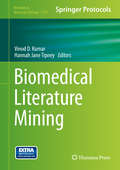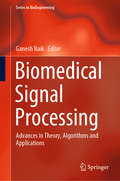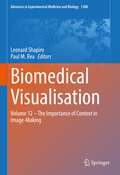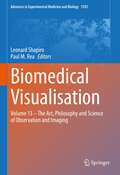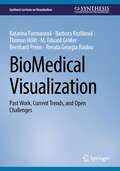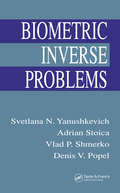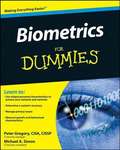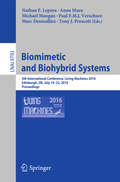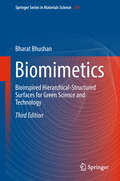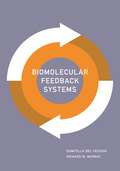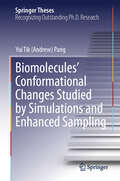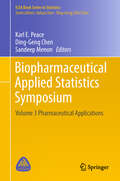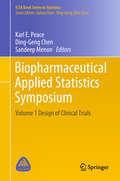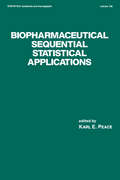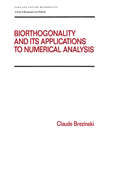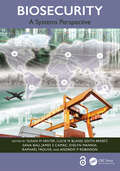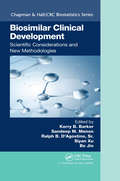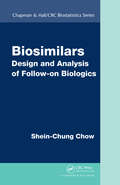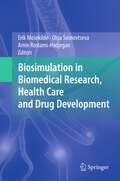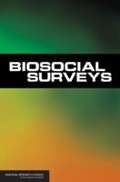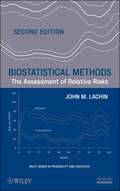- Table View
- List View
Biomedical Literature Mining (Methods in Molecular Biology #1159)
by Vinod D. Kumar Hannah Jane TipneyBiomedical Literature Mining, discusses the multiple facets of modern biomedical literature mining and its many applications in genomics and systems biology. The volume is divided into three sections focusing on information retrieval, integrated text-mining approaches and domain-specific mining methods. Written in the highly successful Methods in Molecular Biology series format, chapters include introductions to their respective topics, lists of the necessary materials and reagents, step-by-step, readily reproducible laboratory protocols and key tips on troubleshooting and avoiding known pitfalls. Authoritative and practical, Biomedical Literature Mining is designed as a useful bioinformatics resource in biomedical literature text mining for both those long experienced in or entirely new to, the field.
Biomedical Signal Processing: Advances in Theory, Algorithms and Applications (Series in BioEngineering)
by Ganesh NaikThis book reports on the latest advances in the study of biomedical signal processing, and discusses in detail a number of open problems concerning clinical, biomedical and neural signals. It methodically collects and presents in a unified form the research findings previously scattered throughout various scientific journals and conference proceedings. In addition, the chapters are self-contained and can be read independently. Accordingly, the book will be of interest to university researchers, R&D engineers and graduate students who wish to learn the core principles of biomedical signal analysis, algorithms, and applications, while also offering a valuable reference work for biomedical engineers and clinicians who wish to learn more about the theory and recent applications of neural engineering and biomedical signal processing.
Biomedical Visualisation: Volume 12 ‒ The Importance of Context in Image-Making (Advances in Experimental Medicine and Biology #1388)
by Leonard Shapiro Paul M. ReaThis image-rich book explores the practice as well as the theory of visual representation and presents us with the importance of designing appropriate images for communication to specific target audiences. This includes the appropriate choice of high-tech digital or low-tech analogue technologies in image-making for communication within the medical education, biological research and community health contexts. We hear from medical students about the value of using clay modelling in their understanding of anatomy, from educators and curriculum designers about visual affordances in medical education and from a community-driven project in South Africa about their innovative use of locally designed images and culture-specific narratives for communicating important health information to marginalised communities. A chapter explores the evolution of scientific visualisation and representation of big data to a variety of audiences, and another presents the innovative 3D construction of internal cellular structures from microscopic 2D slices. As we embrace blended learning in anatomy education, a timely chapter prompts us to think further about and contribute to the ongoing discourse around important ethical considerations in the use and sharing of digital images of body donors. This book will appeal to educators, medical illustrators, curriculum designers, post-graduate students, community health practitioners and biomedical researchers.
Biomedical Visualisation: Volume 13 – The Art, Philosophy and Science of Observation and Imaging (Advances in Experimental Medicine and Biology #1392)
by Leonard Shapiro Paul M. ReaThis book brings together current advances in high-technology visualisation and the age-old but science-adapted practice of drawing for improved observation in medical education and surgical planning and practice. We begin this book with a chapter reviewing the history of confusion around visualisation, observation and theory, outlining the implications for medical imaging. The authors consider the shifting influence of various schools of philosophy, and the changing agency of technology over time. We then follow with chapters on the practical application of visualisation and observation, including emerging imaging techniques in anatomy for teaching, research and clinical practice - innovation in the mapping of orthopaedic fractures for optimal orthopaedic surgical guidance - placental morphology and morphometry as a prerequisite for future pathological investigations - visualising the dural venous sinuses using volume tracing. Two chapters explore the use and benefit of drawing in medical education and surgical planning. It is worth noting that experienced surgeons and artists employ a common set of techniques as part of their work which involves both close observation and the development of fine motor skills and sensitive tool use.An in-depth look at police identikit construction from memory by eyewitnesses to crimes, outlines how an individual’s memory of a suspect’s facial features are rendered visible as a composite image.This book offers anatomy educators and clinicians an overview of the history and philosophy of medical observation and imaging, as well as an overview of contemporary imaging technologies for anatomy education and clinical practice. In addition, we offer anatomy educators and clinicians a detailed overview of drawing practices for the improvement of anatomical observation and surgical planning. Forensic psychologists and law enforcement personnel will not only benefit from a chapter dedicated to the construction of facial composites, but also from chapters on drawing and observation.
BioMedical Visualization: Past Work, Current Trends, and Open Challenges (Synthesis Lectures on Visualization)
by Katarína Furmanová Barbora Kozlíková Thomas Höllt M. Eduard Gröller Bernhard Preim Renata Georgia RaidouThis book provides an overview of the many visualization strategies that have been proposed in recent decades for solving problems within the disciplines of medicine and biology. It also evaluates which visualization techniques applied to various areas of biomedicine have been the most impactful and which challenges can be considered solved using visualization. The topics covered in this book include visualization research in omics, interaction networks and pathways, biological structures, tumor diagnosis and treatment, vasculature, brain, surgery, educational contexts, therapy and rehabilitation, electronic health records, and public health. One chapter is dedicated to general visualization techniques commonly used for biomedical data, such as surface and volume rendering, as well as abstract and illustrative approaches. For each of these areas, the past and present research trends are discussed, highlighting the influential works. Furthermore, the book explains how research is affected by developments in technology, data availability, and domain practice. Individual sections also summarize the typical target users, the nature of the data, and the typical tasks addressed in the given domain. With a uniquely broad scope, the book identifies research trends in biomedical visualization using a manually curated and searchable repository of more than 3,800 publications. The resultant trends are further categorized according to the application field and using natural language processing. The book also utilizes 16 interviews conducted with researchers in the field of biomedical visualization for the purpose of soliciting their opinions regarding the evolution and trends in the domain. The book handles these topics in a concise manner to help readers orient themselves in the already mature and diverse field of biomedical visualization without overwhelming them with technical details. As such, the book can help young researchers to become familiar with past challenges and identify future ones. For more senior researchers, it can serve as an insightful overview of the research field and the direction in which it is heading.
Biometric Inverse Problems
by Svetlana N. Yanushkevich Adrian Stoica Vlad P. Shmerko Denis V. PopelTraditional methods of biometric analysis are unable to overcome the limitations of existing approaches, mainly due to the lack of standards for input data, privacy concerns involving use and storage of actual biometric data, and unacceptable accuracy. Exploring solutions to inverse problems in biometrics transcends such limits and allows rich analysis of biometric information and systems for improved performance and testing. Although some particular inverse problems appear in the literature, until now there has been no comprehensive reference for these problems. Biometric Inverse Problems provides the first comprehensive treatment of biometric data synthesis and modeling. This groundbreaking reference comprises eight self-contained chapters that cover the principles of biometric inverse problems; basics of data structure design; new automatic synthetic signature, fingerprint, and iris design; synthetic faces and DNA; and new tools for biometrics based on Voronoi diagrams. Based on the authors' vast experience in the field, the book authoritatively examines new approaches and methodologies in both direct and inverse biometrics, providing invaluable analytical and benchmarking tools. The authors include case studies, examples, and implementation codes for practical illustration of the methods. Loaded with approximately 200 figures, 60 problems, 50 MATLAB® code fragments, and 200 examples, Biometric Inverse Problems sets the standard for innovation and authority in biometric data synthesis, modeling, and analysis.
Biometrics For Dummies
by Michael A. Simon Peter H. GregoryWhat is biometrics? Whether you're just curious about how biometrics can benefit society or you need to learn how to integrate biometrics with an existing security system in your organization, Biometrics For Dummies can help.Here's a friendly introduction to biometrics -- the science of identifying humans based on unique physical characteristics. With the government's use of biometrics -- for example, biometric passport readers -- and application of the technology for law enforcement, biometrics is growing more popular among security experts. Biometrics For Dummies explains biometric technology, explores biometrics policy and privacy issues with biometrics, and takes a look at where the science is heading. You'll discover:How pattern recognition and fingerprint recognition are usedThe many vulnerabilities of biometric systems and how to guard against themHow various countries are handling the privacy issues and what can be done to protect citizens' privacyHow a scan of the palm, veins in the hand, and sonar imagery establish identityWhat it takes to fully authenticate a signatureHow gait, speech, linguistic analysis, and other types of biometric identification come into playThe criteria for setting up an implementation planHow to use authentication, authorization, and access principlesWritten by a pair of security experts, Biometrics For Dummies gives you the basics in an easy-to-understand format that doesn't scrimp on substance. You'll get up to speed and enjoy getting there!
Biometry for Forestry and Environmental Data: With Examples in R
by Lauri MehtataloBiometry for Forestry and Environmental Data with Examples in R focuses on statistical methods that are widely applicable in forestry and environmental sciences, but it also includes material that is of wider interest. Features: · Describes the theory and applications of selected statistical methods and illustrates their use and basic concepts through examples with forestry and environmental data in R. · Rigorous but easily accessible presentation of the linear, nonlinear, generalized linear and multivariate models, and their mixed-effects counterparts. Chapters on tree size, tree taper, measurement errors, and forest experiments are also included. · Necessary statistical theory about random variables, estimation and prediction is included. The wide applicability of the linear prediction theory is emphasized. · The hands-on examples with implementations using R make it easier for non-statisticians to understand the concepts and apply the methods with their own data. Lot of additional material is available at www.biombook.org. The book is aimed at students and researchers in forestry and environmental studies, but it will also be of interest to statisticians and researchers in other fields as well.
Biomimetic and Biohybrid Systems: 5th International Conference, Living Machines 2016, Edinburgh, UK, July 19-22, 2016. Proceedings (Lecture Notes in Computer Science #9793)
by Tony J. Prescott Michael Mangan Nathan F. Lepora Anna Mura Paul F.M.J. Verschure Marc DesmulliezThis book constitutes the refereed proceedings of the second International Conference on Biomimetic and Biohybrid Systems, Living Machines 2013, held in London, UK, in July/August 2013. The 65 revised full papers presented were carefully reviewed and selected from various submissions. The papers are targeted at the intersection of research on novel live-like technologies inspired by scientific investigation of biological systems, biomimetics, and research that seeks to interface biological and artificial systems to create biohybrid systems
Biomimetics: Bioinspired Hierarchical-Structured Surfaces for Green Science and Technology (Biological and Medical Physics, Biomedical Engineering)
by Bharat BhushanThis book presents an overview of the general field of biomimetics - lessons from nature. It presents various examples of biomimetics, including roughness-induced superomniphobic surfaces which provide functionality of commercial interest. The major focus in the book is on lotus effect, rose petal effect, shark skin effect, and gecko adhesion. For each example, the book first presents characterization of an object to understand how a natural object provides functionality, followed by modeling and then fabrication of structures in the lab using nature’s route to verify one’s understanding of nature and provide guidance for development of optimum structures. Once it is understood how nature does it, examples of fabrication of optimum structures using smart materials and fabrication techniques, are presented. Examples of nature inspired objects are also presented throughout.
Biomolecular Feedback Systems
by Domitilla Del Vecchio Richard MurrayThis book provides an accessible introduction to the principles and tools for modeling, analyzing, and synthesizing biomolecular systems. It begins with modeling tools such as reaction-rate equations, reduced-order models, stochastic models, and specific models of important core processes. It then describes in detail the control and dynamical systems tools used to analyze these models. These include tools for analyzing stability of equilibria, limit cycles, robustness, and parameter uncertainty. Modeling and analysis techniques are then applied to design examples from both natural systems and synthetic biomolecular circuits. In addition, this comprehensive book addresses the problem of modular composition of synthetic circuits, the tools for analyzing the extent of modularity, and the design techniques for ensuring modular behavior. It also looks at design trade-offs, focusing on perturbations due to noise and competition for shared cellular resources.Featuring numerous exercises and illustrations throughout, Biomolecular Feedback Systems is the ideal textbook for advanced undergraduates and graduate students. For researchers, it can also serve as a self-contained reference on the feedback control techniques that can be applied to biomolecular systems.Provides a user-friendly introduction to essential concepts, tools, and applicationsCovers the most commonly used modeling methodsAddresses the modular design problem for biomolecular systemsUses design examples from both natural systems and synthetic circuitsSolutions manual (available only to professors at press.princeton.edu)An online illustration package is available to professors at press.princeton.edu
Biomolecules' Conformational Changes Studied by Simulations and Enhanced Sampling (Springer Theses)
by Yui Tik PangThis thesis illuminates the critical roles biomolecules, from small molecules to proteins, play in cellular functionality, particularly highlighting their conformational changes in response to environmental cues or binding events—a cornerstone concept in drug design as well as the manifestations of disease. It explores the conformational flexibility of small molecules and proteins, essential for predicting drug interactions and understanding biological processes. Through advanced molecular dynamics simulations and enhanced sampling techniques, this research offers unprecedented insights into the structural dynamics of three distinct biomolecular systems: the capsid assembly modulator AT130, the passenger domain of pertactin, and the SARS-CoV-2 spike protein. Each system represents a unique facet of biological complexity, underscoring the thesis's contribution to our understanding of biomolecular behavior across various scales. Furthermore, the thesis advances the field by updating the Force Field Toolkit for improved simulation accuracy. This work not only showcases the adaptability and importance of simulation techniques in modern biological research but also paves the way for novel therapeutic strategies by deepening our understanding of biomolecular dynamics.
Biopharmaceutical Applied Statistics Symposium: Volume 3 Pharmaceutical Applications (ICSA Book Series in Statistics)
by Sandeep Menon Ding-Geng Chen Karl E. PeaceThis BASS book Series publishes selected high-quality papers reflecting recent advances in the design and biostatistical analysis of biopharmaceutical experiments – particularly biopharmaceutical clinical trials. The papers were selected from invited presentations at the Biopharmaceutical Applied Statistics Symposium (BASS), which was founded by the first Editor in 1994 and has since become the premier international conference in biopharmaceutical statistics. The primary aims of the BASS are: 1) to raise funding to support graduate students in biostatistics programs, and 2) to provide an opportunity for professionals engaged in pharmaceutical drug research and development to share insights into solving the problems they encounter.The BASS book series is initially divided into three volumes addressing: 1) Design of Clinical Trials; 2) Biostatistical Analysis of Clinical Trials; and 3) Pharmaceutical Applications. This book is the third of the 3-volume book series. The topics covered include: Targeted Learning of Optimal Individualized Treatment Rules under Cost Constraints, Uses of Mixture Normal Distribution in Genomics and Otherwise, Personalized Medicine – Design Considerations, Adaptive Biomarker Subpopulation and Tumor Type Selection in Phase III Oncology Trials, High Dimensional Data in Genomics; Synergy or Additivity - The Importance of Defining the Primary Endpoint, Full Bayesian Adaptive Dose Finding Using Toxicity Probability Interval (TPI), Alpha-recycling for the Analyses of Primary and Secondary Endpoints of Clinical Trials, Expanded Interpretations of Results of Carcinogenicity Studies of Pharmaceuticals, Randomized Clinical Trials for Orphan Drug Development, Mediation Modeling in Randomized Trials with Non-normal Outcome Variables, Statistical Considerations in Using Images in Clinical Trials, Interesting Applications over 30 Years of Consulting, Uncovering Fraud, Misconduct and Other Data Quality Issues in Clinical Trials, Development and Evaluation of High Dimensional Prognostic Models, and Design and Analysis of Biosimilar Studies.
Biopharmaceutical Applied Statistics Symposium: Volume 3 Pharmaceutical Applications (ICSA Book Series in Statistics)
by Karl E. Peace Ding-Geng Chen Sandeep MenonThis BASS book Series publishes selected high-quality papers reflecting recent advances in the design and biostatistical analysis of biopharmaceutical experiments – particularly biopharmaceutical clinical trials. The papers were selected from invited presentations at the Biopharmaceutical Applied Statistics Symposium (BASS), which was founded by the first Editor in 1994 and has since become the premier international conference in biopharmaceutical statistics. The primary aims of the BASS are: 1) to raise funding to support graduate students in biostatistics programs, and 2) to provide an opportunity for professionals engaged in pharmaceutical drug research and development to share insights into solving the problems they encounter.The BASS book series is initially divided into three volumes addressing: 1) Design of Clinical Trials; 2) Biostatistical Analysis of Clinical Trials; and 3) Pharmaceutical Applications. This book is the first of the 3-volume book series. The topics covered include: A Statistical Approach to Clinical Trial Simulations, Comparison of Statistical Analysis Methods Using Modeling and Simulation for Optimal Protocol Design, Adaptive Trial Design in Clinical Research, Best Practices and Recommendations for Trial Simulations in the Context of Designing Adaptive Clinical Trials, Designing and Analyzing Recurrent Event Data Trials, Bayesian Methodologies for Response-Adaptive Allocation, Addressing High Placebo Response in Neuroscience Clinical Trials, Phase I Cancer Clinical Trial Design: Single and Combination Agents, Sample Size and Power for the Mixed Linear Model, Crossover Designs in Clinical Trials, Data Monitoring: Structure for Clinical Trials and Sequential Monitoring Procedures, Design and Data Analysis for Multiregional Clinical Trials – Theory and Practice, Adaptive Group-Sequential Multi-regional Outcome Studies in Vaccines, Development and Validation of Patient-reported Outcomes, Interim Analysis of Survival Trials: Group Sequential Analyses, and Conditional Power – A Non-proportional Hazards Perspective.
Biopharmaceutical Applied Statistics Symposium: Volume 3 Pharmaceutical Applications (ICSA Book Series in Statistics)
by Karl E. Peace Ding-Geng Chen Sandeep MenonThis BASS book Series publishes selected high-quality papers reflecting recent advances in the design and biostatistical analysis of biopharmaceutical experiments – particularly biopharmaceutical clinical trials. The papers were selected from invited presentations at the Biopharmaceutical Applied Statistics Symposium (BASS), which was founded by the first Editor in 1994 and has since become the premier international conference in biopharmaceutical statistics. The primary aims of the BASS are: 1) to raise funding to support graduate students in biostatistics programs, and 2) to provide an opportunity for professionals engaged in pharmaceutical drug research and development to share insights into solving the problems they encounter.The BASS book series is initially divided into three volumes addressing: 1) Design of Clinical Trials; 2) Biostatistical Analysis of Clinical Trials; and 3) Pharmaceutical Applications. This book is the second of the 3-volume book series. The topics covered include: Statistical Approaches to the Meta-analysis of Randomized Clinical Trials, Collaborative Targeted Maximum Likelihood Estimation to Assess Causal Effects in Observational Studies, Generalized Tests in Clinical Trials, Discrete Time-to-event and Score-based Methods with Application to Composite Endpoint for Assessing Evidence of Disease Activity-Free , Imputing Missing Data Using a Surrogate Biomarker: Analyzing the Incidence of Endometrial Hyperplasia, Selected Statistical Issues in Patient-reported Outcomes, Network Meta-analysis, Detecting Safety Signals Among Adverse Events in Clinical Trials, Applied Meta-analysis Using R, Treatment of Missing Data in Comparative Effectiveness Research, Causal Estimands: A Common Language for Missing Data, Bayesian Subgroup Analysis with Examples, Statistical Methods in Diagnostic Devices, A Question-Based Approach to the Analysis of Safety Data, Analysis of Two-stage Adaptive Seamless Trial Design, and Multiplicity Problems in Clinical Trials – A Regulatory Perspective.
Biopharmaceutical Sequential Statistical Applications (Statistics: A Series of Textbooks and Monographs)
by Karl E. PeaceFocusing on group sequential procedures, summarizes the sequential statistical methods used in anticancer, antiviral, cardiovascular, and gastrointestinal drug research and screening. The clinical and preclinical applications are mainly presented as case studies, many of which form part of New Drug
Biophysics: A Student’s Guide to the Physics of the Life Sciences and Medicine
by William C. ParkeThis comprehensive and extensively classroom-tested biophysics textbook is a complete introduction to the physical principles underlying biological processes and their applications to the life sciences and medicine. The foundations of natural processes are placed on a firm footing before showing how their consequences can be explored in a wide range of biosystems. The goal is to develop the readers’ intuition, understanding, and facility for creative analysis that are frequently required to grapple with problems involving complex living organisms. Topics cover all scales, encompassing the application of statics, fluid dynamics, acoustics, electromagnetism, light, radiation physics, thermodynamics, statistical physics, quantum biophysics, and theories of information, ordering, and evolutionary optimization to biological processes and bio-relevant technological implementations. Sound modeling principles are emphasized throughout, placing all the concepts within a rigorous framework. With numerous worked examples and exercises to test and enhance the reader’s understanding, this book can be used as a textbook for physics graduate students and as a supplementary text for a range of premedical, biomedical, and biophysics courses at the undergraduate and graduate levels. It will also be a useful reference for biologists, physicists, medical researchers, and medical device engineers who want to work from first principles.
Biorthogonality and its Applications to Numerical Analysis (Chapman And Hall/crc Pure And Applied Mathematics Ser. #156)
by Claude BrezinskiThis book explores the use of the concept of biorthogonality and discusses the various recurrence relations for the generalizations of the method of moments, the method of Lanczos, and the biconjugate gradient method. It is helpful for researchers in numerical analysis and approximation theory.
Biosafety and Biosecurity: Practical Insights and Applications for Low and Middle-Income Countries
by Jonathan Jaime G. Guerrero, Rohani Cena-Navarro, Raul V. Destura, Marian P. De Leon, Kin Israel R. Notarte, and Mark Angelo O. BalendresThere are many guidelines, protocols and advisories that outline how biosafety and biosecurity can be adopted by institutions around the world. Whilst helpful, many of these are tailored to affluent Western nations. This leaves developing nations far behind since their laboratories and institutions are resource-scarce and biosafety and biosecurity are not mainstreamed entirely among the different laboratory workers, healthcare professionals, researchers, and academics. Biosafety and Biosecurity: Practical Insights and Applications for Low and Middle-Income Countries aims to bridge this gap by comprehensively summarizing the state and development of biosafety and biosecurity in developing and developed nations in a comparative analysis. This book includes basic concepts and principles of biosafety and biosecurity, including certification and legal frameworks, both international and local, and biosafety and biosecurity across disciplines including environmental, medical, and special topics that are relevant to countries with comparable conditions. This proposed book solves the problem of the lack of a prescribed professional title that comprehensively summarizes the state and development of biosafety and biosecurity throughout the world, allowing the reader a 360 view of the subject area.This book will appeal to a global audience of biorisk officers, health and safety professionals and specialists in the life sciences, health and allied fields, environmental science, engineering, and plant and animal agriculture.
Biosecurity: A Systems Perspective (A life skills manual)
by Andrew P. Robinson Susan M. Hester Lucie M. Bland Edith Arndt Sana Bau James S. Camac Evelyn Mannix Raphaël TrouvéBiosecurity: A Systems Perspective provides an overview of biosecurity as a system of related components, actors, and risks. This book—directed to the biosecurity practitioner, generalist scientist, and student—introduces overall features of the biosecurity system while walking the reader through the most up-to-date research on each step of the continuum (i.e. pre-border, border, and post-border activities). This book, which explicitly incorporates economic and social dimensions as well as varied decision-making contexts, paves the way for a more systemic approach to biosecurity risk management. The work spans statistics, ecology, mathematics, economics, veterinary science, human medicine, and sociology, involving collaborators across government, academia, and the private sector. This book uses a broad definition of biosecurity, rather than solely focusing on plant health, animal health, security, or one step of the biosecurity system (e.g. surveillance). As such, this book is a one-stop shop for readers interested in all aspects of biosecurity. The content and language are accessible to a wide range of audiences, including generalist scientists, biosecurity practitioners, and graduate students. More complex content is introduced in standalone boxes or chapters. The book follows a clear, simple structure within and among chapters (i.e. following the structure of the biosecurity system), making it a preferred option for graduate students. This book introduces novel cross-cutting themes, such as the importance of economic efficiency and institutional and social factors, going beyond the traditional science-based approach to biosecurity. Written in partnership with government agency practitioners, this book uses on-the-ground case studies to demonstrate how biosecurity principles are applied in practice. The book addresses challenges common to regulators in general, namely efficient regulation in uncertain and rapidly changing environments with multiple stakeholders who have—at times—conflicting priorities. Chapters 6, 7, 8, 9 and 14 are available to read Open Access via Creative Commons Attribution-No Derivatives (CC-BY-ND) 4.0, at https://www.taylorfrancis.com/books/edit/10.1201/9781003253204/.
Biosimilar Clinical Development: Scientific Considerations and New Methodologies (Chapman & Hall/CRC Biostatistics Series)
by Kerry B. Barker Sandeep M. Menon Ralph B. D’Agostino Sr. Siyan Xu Bo JinBiosimilars have the potential to change the way we think about, identify, and manage health problems. They are already impacting both clinical research and patient care, and this impact will only grow as our understanding and technologies improve. Written by a team of experienced specialists in clinical development, this book discusses various potential drug development strategies, the design and analysis of pharmacokinetics (PK) studies, and the design and analysis of efficacy studies.
Biosimilars: Design and Analysis of Follow-on Biologics
by Shein-Chung ChowAs many biological products face losing their patents in the next decade, the pharmaceutical industry needs an abbreviated regulatory pathway for approval of biosimilar drug products, which are cost-effective, follow-on/subsequent versions of the innovator's biologic products. But scientific challenges remain due to the complexity of both the manuf
Biosimulation in Biomedical Research, Health Care and Drug Development
by Olga Sosnovtseva Amin Rostami-Hodjegan Erik MosekildeBiosimulation is an approach to biomedical research and the treatment of patients in which computer modeling goes hand in hand with experimental and clinical work. Constructed models are used to interpret experimental results and to accumulate information from experiment to experiment. This book explains the concepts used in the modeling of biological phenomena and goes on to present a series of well-documented models of the regulation of various genetic, cellular and physiological processes. The way how the use of computer models allows optimization of cancer treatment for individual patients is discussed and models of interacting nerve cells that can be used to design new treatments for patients with Parkinson's disease are explained. Furthermore this volume provides an overview on the use of models in industry, and presents the view of regulatory agencies on the topic.
Biosocial Surveys
by National Research Council of the National AcademiesBiosocial Surveys analyzes the latest research on the increasing number of multipurpose household surveys that collect biological data along with the more familiar interviewer–respondent information. This book serves as a follow-up to the 2003 volume, Cells and Surveys: Should Biological Measures Be Included in Social Science Research? and asks these questions: What have the social sciences, especially demography, learned from those efforts and the greater interdisciplinary communication that has resulted from them? Which biological or genetic information has proven most useful to researchers? How can better models be developed to help integrate biological and social science information in ways that can broaden scientific understanding? This volume contains a collection of 17 papers by distinguished experts in demography, biology, economics, epidemiology, and survey methodology. It is an invaluable sourcebook for social and behavioral science researchers who are working with biosocial data.
Biostatistical Methods
by John M. LachinPraise for the First Edition". . . an excellent textbook . . . an indispensable reference for biostatisticians and epidemiologists."--International Statistical InstituteA new edition of the definitive guide to classical and modern methods of biostatisticsBiostatistics consists of various quantitative techniques that are essential to the description and evaluation of relationships among biologic and medical phenomena. Biostatistical Methods: The Assessment of Relative Risks, Second Edition develops basic concepts and derives an expanded array of biostatistical methods through the application of both classical statistical tools and more modern likelihood-based theories. With its fluid and balanced presentation, the book guides readers through the important statistical methods for the assessment of absolute and relative risks in epidemiologic studies and clinical trials with categorical, count, and event-time data.Presenting a broad scope of coverage and the latest research on the topic, the author begins with categorical data analysis methods for cross-sectional, prospective, and retrospective studies of binary, polychotomous, and ordinal data. Subsequent chapters present modern model-based approaches that include unconditional and conditional logistic regression; Poisson and negative binomial models for count data; and the analysis of event-time data including the Cox proportional hazards model and its generalizations. The book now includes an introduction to mixed models with fixed and random effects as well as expanded methods for evaluation of sample size and power. Additional new topics featured in this Second Edition include:Establishing equivalence and non-inferiorityMethods for the analysis of polychotomous and ordinal data, including matched data and the Kappa agreement indexMultinomial logistic for polychotomous data and proportional odds models for ordinal dataNegative binomial models for count data as an alternative to the Poisson modelGEE models for the analysis of longitudinal repeated measures and multivariate observationsThroughout the book, SAS is utilized to illustrate applications to numerous real-world examples and case studies. A related website features all the data used in examples and problem sets along with the author's SAS routines.Biostatistical Methods, Second Edition is an excellent book for biostatistics courses at the graduate level. It is also an invaluable reference for biostatisticians, applied statisticians, and epidemiologists.
